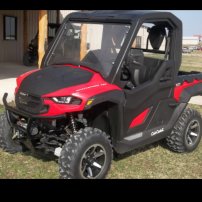2017 cub challenger exhaust upgrade.
-
Similar Topics
-
By FTG-05
I want to ditch my Kubota RTV-XG850 and its moronic twitchy throttle design flaw, get rid of the problematic engine and the 40 mph purposely throttled speed.
So far, I'm looking at the Honda Pioneer 1000 and the Polaris Ranger 1000, both of which have 1000-1500 lb payload bed capacity.
What other makes and models should I be looking at?
Thanks for the help!
-
By Homeowner A
Coleman UT 400 has a strong sulfur/emissions smell from exhaust all the time. Kind of like it’s running rich and a catalytic converter is trying to make it run cleaner so it smells bad. Also misfires when warm. Idles fine. Full throttle fine. In between it cuts out. Do these have catalytic converters? Almost acts like it might be clogged if so.
-
By didgeridoo
Hello, All! I've decided to replace the traction batteries in my 2018 Sector E1 with a 48V Lithium set. They may be expensive, but I figure the Discovery Dry Cell are, too. I am not looking for the max driving range, as I have never received near the brochured range to begin with, but a good mix of charge/ get work done/ charge is what I am expecting.
I have settled on the 48V EAGL kit from bigbattery dot com. Each battery pack provides 30Ah. The kit ships with a charger, as well. The packs would be physically connected in parallel (using a busbar) to one another, maintaining the 48V voltage, but together would be able to provide the amp draw the buggy pulls when going up hill or towing a rake (rated 320 max continuous Amps). This is in comparison to the serial connection the eight 6V lead batteries. Each of the EAGL batteries looks to have its own BMS; am I correct in thinking I will have to use their included charger rather than (simply) changing the onboard charger to lithium mode? The chemistry of the pack is LiFe PO4, for what it's worth. I haven't torn anything apart yet (to diagram), so I am not sure how the dash will interpret the AMP draw, but the kit I am looking at includes a dash mounted charge indicator.
If anyone has completed a similar conversion, do you have any tips? Specifically, how did you remove the original batteries, and how did you secure the new ones? I am guessing that almost any change from the stock batteries would involve at least some modifications. Any tips would be appreciated, especially things I may have failed to consider. Thanks!
-
By Tejun
Neighbor rode their Coleman with the park brake apparently not fully released. Needless to say, things got pretty hot and even started smoking and the smoke was definitely gear oil smell. Looks like oil is coming from the area just behind the disc for the park break. Looking at parts diagram, there is an oring behind the nut/washer that attaches the flange to pinion shaft. I'm not finding anything on YT that would help with disassembly. Anyone have some experience with removing rear driveshaft ?
-
-
By lincolnsq175
Ive searched and cannot find any performance parts that fit my machine.
I have a 2020 coleman ut400.
Im looking for machined sheave kit, programmers, cdi, exhaust and intake.
I know these are yamaha rhino clones but are they rhino 450 clones?
Any info is appreciated.
-







Recommended Posts
Join the conversation
You can post now and register later. If you have an account, sign in now to post with your account.
Note: Your post will require moderator approval before it will be visible.